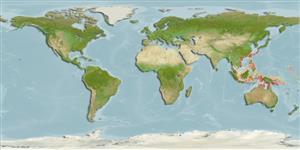>
Gobiiformes (Gobies) >
Gobiidae (Gobies) > Gobiinae
Etymology: Istigobius: Greek, istios = sail + Latin, gobius = gudgeon (Ref. 45335).
Eponymy: Dr Douglas Houghton Campbell (1859–1953) was a botanist and a Professor at Stanford University. [...] (Ref. 128868), visit book page.
More on authors: Jordan & Snyder.
Environment: milieu / climate zone / depth range / distribution range
Sinh thái học
Biển gần đáy; Mức độ sâu 3 - 14 m. Tropical; 30°N - 15°S
Northwest Pacific: southern Japan, Taiwan, and Hong Kong.
Length at first maturity / Bộ gần gũi / Khối lượng (Trọng lượng) / Age
Maturity: Lm ?, range 2 - ? cm
Max length : 7.1 cm TL con đực/không giới tính; (Ref. 420); 7.8 cm TL (female)
Các tia vây lưng cứng (tổng cộng) : 7; Các vây lưng mềm (tổng cộng) : 10 - 11; Tia cứng vây hậu môn: 1; Tia mềm vây hậu môn: 9 - 10; Động vật có xương sống: 26. Upper pectoral fin rays entire. Predorsal cycloid scales 10-13; ctenoid on trunk. Body dusky brown with red spots; 4 blue spots on operculum; black line running from eye along sensory pore path to pectoral base; 2 dusky blotches on pectoral base, the uppermost spreading onto fin rays; large inverted `U'-shaped blotch on the cheek. In male, appressed anal fin occasionally reaching caudal fin, appressed dorsal reaching or overlapping caudal fin. Appressed anal and dorsal fins of female ending 2-3 and 1-2 scales, respectively, of caudal fin.
Common in sandy bottoms of shallow waters. Also observed to live solitarily or in small schools near crevices or under stones. Occurs at 21.5 °C (Ref. 4959).
Genital papilla of male terminating to side of anal spine, of female terminating well before origin of anal fin and sometimes it is slightly pigmented.
Murdy, E.O. and D.F. Hoese, 1985. Revision of the gobiid fish genus Istigobius. Indo-Pac. Fish. (4):41 p. (Ref. 420)
IUCN Red List Status (Ref. 130435: Version 2024-1)
Threat to humans
Harmless
Human uses
Các công cụ
Special reports
Download XML
Các nguồn internet
Estimates based on models
Preferred temperature (Ref.
123201): 24.3 - 28.1, mean 27.4 °C (based on 299 cells).
Phylogenetic diversity index (Ref.
82804): PD
50 = 0.5010 [Uniqueness, from 0.5 = low to 2.0 = high].
Bayesian length-weight: a=0.01023 (0.00477 - 0.02194), b=3.01 (2.83 - 3.19), in cm total length, based on LWR estimates for this (Sub)family-body shape (Ref.
93245).
Mức dinh dưỡng (Ref.
69278): 3.3 ±0.3 se; based on size and trophs of closest relatives
Thích nghi nhanh (Ref.
120179): Chiêù cao, thời gian nhân đôi của chủng quần tối thiểu là dưới 15 tháng (Preliminary K or Fecundity.).
Fishing Vulnerability (Ref.
59153): Low vulnerability (10 of 100).
Nutrients (Ref.
124155): Calcium = 455 [217, 1,141] mg/100g; Iron = 1.73 [0.93, 3.44] mg/100g; Protein = 17.6 [15.8, 19.2] %; Omega3 = 0.235 [0.094, 0.480] g/100g; Selenium = 30.1 [14.5, 66.1] μg/100g; VitaminA = 39.3 [10.9, 126.7] μg/100g; Zinc = 2.31 [1.53, 3.52] mg/100g (wet weight);
